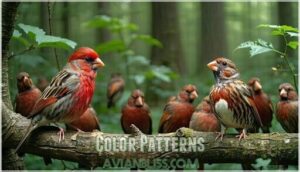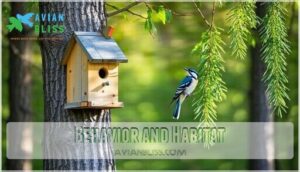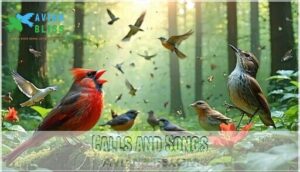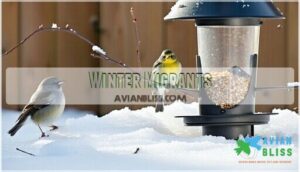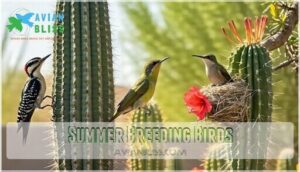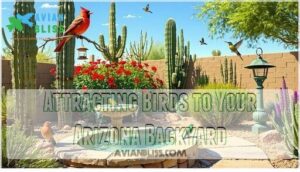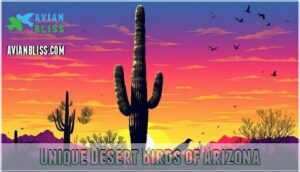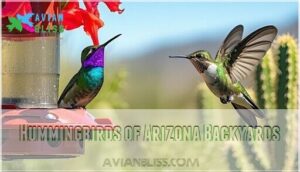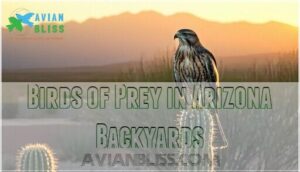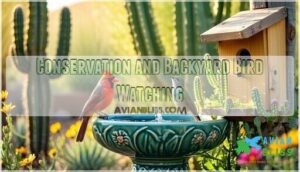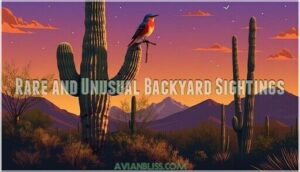This site is supported by our readers. We may earn a commission, at no cost to you, if you purchase through links.
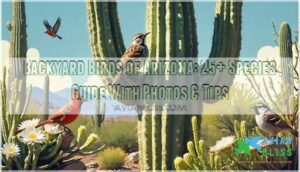
You’ll often spot Mourning Doves cooing softly or House Finches with their cheerful red plumage. Northern Cardinals add a splash of crimson, while Anna’s Hummingbirds zip around like tiny jewels.
Keep an eye out for Gambel’s Quail scurrying in groups or the Cactus Wren, Arizona’s state bird, perched on desert plants.
To attract these beauties, try native plants, water features, and feeders with seeds or nectar. Each season brings new visitors, so there’s always something to watch, and you’ll be ready to discover even more feathered friends with a mix of vibrant species.
Table Of Contents
- Key Takeaways
- Common Backyard Birds in Arizona
- Identifying Backyard Birds
- Seasonal Visitors to Arizona Backyards
- Attracting Birds to Your Arizona Backyard
- Unique Desert Birds of Arizona
- Hummingbirds of Arizona Backyards
- Birds of Prey in Arizona Backyards
- Conservation and Backyard Bird Watching
- Photographing Backyard Birds in Arizona
- Rare and Unusual Backyard Sightings
- Frequently Asked Questions (FAQs)
- What are the most common backyard birds in Arizona?
- Where can I find birds in Arizona?
- What are the most common backyard birds?
- What are the most common birds in Arizona?
- How do I identify a bird in my yard?
- What is the small GREY bird in Arizona?
- What is Arizona’s native bird?
- How do I identify a bird in my backyard?
- What is the main bird in Arizona?
- What is the most common bird in Phoenix Arizona?
- Conclusion
Key Takeaways
- Attract birds by planting native species, adding water features, and setting up feeders with seeds or nectar.
- Learn to identify birds by observing size, color patterns, beak shape, and behavior.
- Common backyard birds include Mourning Doves, House Finches, Northern Cardinals, and Anna’s Hummingbirds.
- Seasonal visitors like Western Tanagers and Yellow-rumped Warblers add variety during migration.
Common Backyard Birds in Arizona
You’ll spot these familiar birds in Arizona backyards almost every day throughout the year.
Mourning Doves, House Finches, Northern Cardinals, and Anna’s Hummingbirds make up the core group that visits feeders and water sources regularly in desert neighborhoods, including the Mourning Doves.
Mourning Dove
Mourning doves grace nearly half of Arizona backyards year-round, making them your most reliable feathered neighbors. These gentle birds embody peace in dove symbolism, while their soft cooing dove sounds create nature’s lullaby at dawn and dusk.
Spot them by these key features:
- Plump, teardrop-shaped bodies with delicate heads
- Long, pointed tails edged in bright white
- Warm brown-pink plumage with subtle iridescence
- Bold black wing spots that flash during flight
- Distinctive orange-red legs and dark, beady eyes
Their simple dove diet focuses on seeds, while their flimsy dove nesting habits produce multiple broods annually in your Arizona backyard.
House Finch
House finches are Arizona’s most reliable backyard visitors, appearing in nearly half of all bird counts.
Males flash bright red heads and chests, while females wear subtle brown streaks.
These adaptable birds thrive in urban settings, building nests in hanging plants or building eaves.
| Aspect | Details |
|---|---|
| Male Colors | Bright red head, chest, rump |
| Female Colors | Brown streaked throughout |
| Preferred Food | Sunflower seeds, Nyjer seeds |
| Nesting Sites | Eaves, plants, structures |
Their cheerful warbling brightens any morning.
Northern Cardinal
Northern Cardinal males flash bright red feathers like living flames against Arizona’s desert backdrop.
You’ll easily spot these year-round residents in dense shrubs and state parks.
Their cheerful songs echo through backyards during all seasons since they don’t migrate.
Cardinals eat seeds and insects, making them regular visitors to your bird feeders.
Look for their thick orange beaks and distinctive crest when identifying these striking Arizona birds in your backyard habitat.
Anna’s Hummingbird
You’ll spot Anna’s Hummingbirds year-round in Arizona backyards, their iridescent plumage shimmering green and rose-red in sunlight.
Anna’s Hummingbirds dazzle year-round in Arizona, flashing iridescent green and rose-red hues as they hover gracefully in sunlight.
These tiny Arizona birds have mastered winter survival unlike other hummingbird species that migrate south.
Males perform spectacular mating rituals with dive-bomb displays reaching 60 mph.
They’re territorial defenders of nectar sources, chasing away competitors twice their size.
Anna’s Habitat includes gardens, parks, and desert edges where they find food and shelter.
- Fill feeders with fresh sugar water (1:4 ratio) every few days
- Plant native flowering plants like chuparosa and fairy duster
- Provide shallow water sources for drinking and bathing
Identifying Backyard Birds
You’ll need to look at a bird’s size, shape, and color patterns to tell one species from another in your Arizona backyard.
Learning to watch their behavior and listen to their calls will help you identify even the trickiest birds quickly.
Size and Shape
Size and shape are key for bird identification. Pay attention to bill shapes—a finch’s short, conical bill hints at seed-eating, while a hummingbird’s long bill signals nectar feeding.
Look at wing span and tail length to gauge agility or flight style. Here’s a quick comparison:
| Bird Species | Body Proportions | Tail Length |
|---|---|---|
| Mourning Dove | Sleek, plump body | Long, pointed |
| Gila Woodpecker | Compact, sturdy frame | Medium |
| Lesser Goldfinch | Tiny, rounded build | Short |
These clues make Arizona backyard birds easier to spot!
Color Patterns
When identifying Arizona backyard birds, pay close attention to their color patterns. These can reveal surprises like the Male Plumage of a house finch, glowing red, or the subtle Female Plumage, often streaked brown.
Some species show Seasonal Variation, such as the lesser goldfinch, whose colors shift with the time of year. Light and dark patterns are also essential for identification.
- Markings: Look for unique stripes or spots.
- Regional Differences: Birds may adapt colors based on their habitat.
- Color Mutations: Rare variations add excitement.
- Camouflage: Blending plumage offers protection.
- Bright vs. Subtle: Males often outshine females.
Behavior and Habitat
Understanding bird behavior and habitat preferences adds depth to your birdwatching.
Pay attention to how they forage, nest, or interact socially.
Mourning Doves prefer open spaces, often seen roosting on fences.
House Finches thrive in urban areas, flocking to feeders.
Anna’s Hummingbirds hover gracefully in gardens.
Here’s a snapshot:
| Species | Behavior | Habitat |
|---|---|---|
| Mourning Dove | Ground foraging | Open areas |
| House Finch | Social flocks | Urban, suburban |
| Anna’s Hummingbird | Hovering at flowers | Gardens, feeders |
| Cactus Wren | Tail-flicking antics | Desert scrub |
Calls and Songs
Listening for bird sounds adds a new layer to bird identification.
Arizona’s backyard birds have fascinating calls and songs, each with its own charm:
- Mourning Dove: A soft, mournful coo.
- House Finch: A lively, warbling tune.
- Northern Cardinal: Clear whistles of "cheer-cheer-cheer."
- Cactus Wren: Harsh, chattering notes.
These vocalizations reveal their communication and song structure.
Seasonal Visitors to Arizona Backyards
Some birds only visit Arizona during certain times of the year, making your backyard a seasonal hotspot.
You might spot winter migrants, summer breeders, or even birds passing through during spring and fall.
Winter Migrants
Winter migrants bring life to Arizona backyards when food scarcity drives them south.
You’ll notice Dark-eyed Juncos hopping below feeders and White-crowned Sparrows scratching for seeds.
Yellow-rumped Warblers, with their bright flashes, follow migration routes to trees nearby.
Offer suet and millet to support their winter survival, and add a heated birdbath for hydration.
Arizona’s winter birdlife includes the Cooper’s Hawk, known for preying on songbirds.
Roosting habits vary, so keep an eye out for these fascinating travelers during their seasonal arrival timing.
Summer Breeding Birds
As summer unfolds in Arizona, your backyard becomes a bustling hub for bird nesting and breeding season.
Watch for native species showcasing fascinating breeding behaviors. Look closely, and you might spot nests hidden in plain sight.
Here’s what to observe:
- Nesting Habitats: From cacti to shaded trees.
- Breeding Behaviors: Mating calls and territorial displays.
- Summer Migration: Species arriving for food availability.
- Nesting Success: Cleverly built nests ensuring survival.
Nature’s creativity is on full display!
Monitoring efforts can benefit from citizen science initiatives.
Spring and Fall Transients
As the breeding season wraps up, Arizona’s backyards become pit stops for migrating birds.
These spring and fall transients are like feathered tourists, offering a brief but colorful spectacle.
Keep your binoculars handy for these visitors:
- Western Tanagers: Bright red and yellow beauties, passing through on their northern routes.
- Lazuli Buntings: Small gems with blue backs and rusty chests.
- Swainson’s Thrushes: Known for their flute-like melodies, they rely on stopover habitats for rest and food during migration.
Enjoy these fleeting moments!
Attracting Birds to Your Arizona Backyard
You can turn your Arizona backyard into a bird haven by offering the right mix of food, water, and shelter.
Using native plants, setting up feeders, and providing fresh water will attract a variety of species year-round, creating a bird haven.
Native Plants for Birds
Native plants for birds are like a buffet for Arizona wildlife.
Saguaro cacti provide nesting habitats for Gila Woodpeckers, while Ocotillo offers desert nectar for hummingbirds.
Palo Verde trees attract seed-loving Gambel’s Quail, and Wolfberry shrubs produce berries for thrashers.
Arizona plant enthusiasts can find related products online.
By planting these, your backyard becomes a birdfriendly garden, buzzing with life and supporting insect attraction, berry production, and nesting habitat for backyard birds.
Water Sources
In Arizona’s dry climate, water is like a desert oasis for backyard birds.
Add shallow bird baths, dripping hoses, or small fountains to attract them.
Keep water clean and fresh—especially during scorching summers.
Place these bird water sources near shrubs or trees for safety.
Remember, water quality matters.
A well-maintained setup invites vibrant Arizona wildlife while offering hydration and a cool spot to rest.
Bird Feeders and Food Types
To attract backyard birds, use different bird feeders and food types.
Try these:
- Seed Types: Black oil sunflower seeds and Nyjer attract finches and sparrows.
- Feeder Placement: Place feeders near shrubs for safety and easy access.
- Feeder Cleaning: Clean regularly to prevent disease.
- Squirrel Deterrents: Use squirrel-proof feeders to protect bird food.
Don’t forget water feeders—hydration is key for birds in Arizona’s dry climate!
Many options are available if you need bird feeders.
Unique Desert Birds of Arizona
Arizona’s deserts are home to fascinating birds like the Cactus Wren, Gambel’s Quail, and Gila Woodpecker.
You’ll often spot these species thriving among cacti, shrubs, and arid landscapes.
Cactus Wren
The Cactus Wren, a standout among Arizona bird species, thrives in desert landscapes.
Its Cactus Wren habitat includes cholla and saguaro cacti, where it builds spherical nests offering safety from predators.
Known for its bold vocalizations, this bird’s ratcheting call often echoes through backyards.
Foraging mainly on insects, it’s an integral part of desert ecosystems.
Spotting this backyard bird adds excitement to birdwatching and highlights the importance of preserving desert bird habitats.
Gambel’s Quail
When you spot a Gambel’s Quail, you’ll notice their quirky topknots bouncing as they dart around.
These plump, ground-dwelling birds thrive in desert landscapes, making them a favorite among Arizona bird species.
Their quail habitat includes brushy areas and cacti, where they forage for seeds, insects, and fruits.
Known for their social behavior, Gambel’s Quail often gather in coveys, offering safety in numbers.
During breeding season, males perform charming displays to attract mates.
To enjoy these backyard birds, provide native plants and water sources—perfect for birdwatching in Arizona and supporting this species’ conservation status.
Gila Woodpecker
In terms of desert adaptation, the Gila Woodpecker is a standout in the Sonoran Ecosystem.
You’ll often see these backyard birds drilling nest holes in saguaros, a key part of their nesting habits.
Their black-and-white barred backs and tan heads make bird identification easy.
With an insect diet and a knack for sipping cactus nectar, their woodpecker behavior perfectly suits Arizona’s arid landscape.
Listen for their loud, echoing calls!
Hummingbirds of Arizona Backyards
You’ll find hummingbirds like Costa’s and Black-chinned zipping around Arizona backyards, especially during warmer months. These tiny birds are fast, colorful, and love nectar-filled feeders or native flowers.
Costa’s Hummingbird
Costa’s hummingbirds are dazzling backyard birds in Arizona, known for their vibrant purple gorgets and unique desert adaptation.
These tiny fliers thrive in arid habitats, often outshining Anna’s hummingbirds with their bold mating rituals. Males perform dramatic U-shaped dives during courtship, a must-see for birdwatching enthusiasts.
To spot them, visit prime birdwatching destinations during migration. Protecting their Costas habitat guarantees their conservation status remains stable, letting these desert jewels dazzle for generations, which is crucial for their conservation status.
Black-chinned Hummingbird
Black-chinned Hummingbirds are energetic backyard birds you’ll often see zipping around Arizona.
They thrive in arid landscapes and are easily drawn to bird feeders filled with nectar sources. Known for their shimmering purple throats and black chins, these tiny acrobats fiercely defend their territory.
Their breeding habits include nesting in shrubs or trees, while their migration patterns take them to western Mexico in winter.
Creating a bird-friendly backyard helps combat habitat loss and supports their conservation status.
Birds of Prey in Arizona Backyards
You might spot impressive birds of prey like Cooper’s Hawks, Harris’s Hawks, or Great Horned Owls right in your backyard.
These skilled hunters help control rodent populations and add a touch of wild beauty to Arizona neighborhoods.
Cooper’s Hawk
Cooper’s Hawks are stealthy hunters, often zipping through trees with laser focus.
They’re bold enough to patrol urban backyards, making them a backyard threat to smaller birds.
With sharp vision and quick reflexes, they excel at surprise attacks.
These hawks prefer tall trees for nesting and adapt well to Arizona’s mix of woodlands and cityscapes.
- Coopers ID: Slate-gray back, reddish-barred chest
- Hunting Behavior: Ambush predator, lightning-fast strikes
- Nesting Habits: Tall, dense trees, stick-built nests
- Urban Adaptation: Thrives in cities, suburban areas
Harris’s Hawk
Harris’s Hawks are standout backyard birds in Arizona, known for their desert adaptation and family hunting.
These raptors use cooperative breeding and teamwork to catch prey like rabbits and rodents.
With rich dark brown feathers and chestnut shoulders, they’re easy to spot.
Their stable conservation status makes them a favorite in any Arizona bird species guide or birdwatching tips list. They’re a part of the raptor family dynamics in the Sonoran Desert, showcasing unique raptor family behaviors.
Great Horned Owl
The Great Horned Owl, a top predator among Arizona’s backyard birds, is famous for its haunting hoots and piercing yellow eyes.
Known for its adaptable hunting strategies, this owl preys on rodents, rabbits, and even skunks.
With a varied diet and nesting habits in trees or cliffs, it thrives in diverse owl habitats, enchanting birdwatching communities across the state, making it a notable figure with its haunting hoots.
Conservation and Backyard Bird Watching
You can help protect Arizona’s birds by making your yard a safe and welcoming space. Simple steps like planting native shrubs and keeping windows bird-safe make a big difference.
Citizen Science Projects
Get into birdwatching and contribute to science through citizen science projects in Arizona.
Here’s how:
- Bird Monitoring: Track and record species in your backyard.
- Project Participation: Join counts like the Great Backyard Bird Count.
- Data Collection: Share sightings on platforms like eBird for research.
- Citizen Science Impact: Help scientists study bird populations and trends.
It’s fun and meaningful!
These efforts greatly aid bird conservation strategies.
Creating Bird-friendly Habitats
Creating bird-friendly habitats starts with thoughtful Plant Selection.
Use native plants to provide food and shelter for backyard birds.
Add Water Features like birdbaths or small fountains—they’re irresistible in Arizona’s heat.
Install Nesting Boxes to encourage breeding.
Keep cats indoors to guarantee Predator Control.
Here’s a quick guide:
| Feature | Purpose | Example |
|---|---|---|
| Native Plants | Food/Shelter | Mesquite, Desert Sage |
| Water Features | Drinking/Bathing | Birdbath, Fountain |
| Nesting Boxes | Safe Breeding Sites | Wooden Birdhouses |
Design your Habitat to attract species year-round!
Reducing Window Collisions
Protect backyard birds by adding Window Film or External Screens to reduce reflections.
Use Bird-Safe Glass or space decals 2-4 inches apart for better visibility.
Place bird feeders close to windows or far away to minimize collisions.
Keep birds busy with birdhouses and birdfriendly gardens.
These simple Habitat Modifications support bird conservation while making your backyard a safer, livelier space.
Photographing Backyard Birds in Arizona
You can capture stunning photos of Arizona’s backyard birds with the right equipment and a little patience.
Focus on natural light, steady angles, and early mornings when birds are most active.
Camera Equipment
To capture Arizona’s backyard birds, your birdwatching gear needs the right tools.
- Camera Lenses: A 300mm+ telephoto lens helps snap distant birds.
- Tripod Selection: A sturdy tripod keeps your shots sharp and steady.
- Lighting Equipment: Use reflectors or diffusers to manage harsh sunlight.
Consider purchasing a camera telephoto lens for superior results.
Experiment with camera settings to balance motion and light, enhancing your bird photography adventures!
Techniques for Bird Photography
Fine-tune your bird photography with smart camera settings like a fast shutter speed to freeze motion.
Use composition tips to frame birds naturally—think branches or feeders.
Study lighting techniques for soft morning or evening light.
Watch bird behavior to predict movements.
Here’s a quick guide:
| Setting | Use For | Example |
|---|---|---|
| Fast Shutter | Action shots | Hummingbirds in flight |
| Low ISO | Clearer images | Still birds on branches |
| Wide Aperture | Blurred background | Isolated bird portraits |
Stay patient, and keep observing!
Best Times and Locations
Morning light paints the perfect backdrop for photographing backyard birds in Arizona.
Spring is a prime season, showcasing vibrant plumage and nesting activity. Focus on birdwatching locations with native plants, water features, and varied elevations.
Urban hotspots can surprise you with migration patterns. Explore Arizona birdwatching locations like your yard or nearby parks—nature’s best birdwatching destinations are often closer than you think!
Prioritize using fast shutter speeds to capture sharp images.
Rare and Unusual Backyard Sightings
Sometimes, you might spot a bird in your yard that feels like a rare treasure.
Keep an eye out for unusual visitors like the Elf Owl, Pyrrhuloxia, or Vermilion Flycatcher, as they can make your backyard birdwatching extra special.
Elf Owl
Spotting an elf owl in Arizona is like finding a tiny treasure.
These pint-sized backyard birds favor desert habitats and nest in old woodpecker holes or nesting boxes.
Their high-pitched vocalizations echo through the night as they hunt insects, their primary diet.
Keep watch for owl pellets—nature’s little mysteries—and join birdwatching groups to share your sightings and tips!
Pyrrhuloxia
The Pyrrhuloxia, a desert gem, thrives in Arizona’s arid landscapes.
Often mistaken for a Northern Cardinal, it enchants with its unique look and lively song.
- Pyrrhuloxia Habitat: Deserts, scrublands
- Pyrrhuloxia Diet: Seeds, insects
- Pyrrhuloxia Nesting: Low shrubs, cacti
- Pyrrhuloxia Conservation: Stable but habitat-sensitive
Add bird feeders with mixed seeds to invite this striking visitor!
Vermilion Flycatcher
The Vermilion Flycatcher is a striking bird species native to Arizona’s open desert habitats.
Their fiery red color and bold Flycatcher Behavior make them easy to spot during migration or breeding. They feast on insects, catching them mid-air.
Here’s a quick birdwatching guide:
Trait Details Tips
Habitat
Diet
Nesting
Frequently Asked Questions (FAQs)
What are the most common backyard birds in Arizona?
You’ll find Arizona’s backyard stars like the House Finch and Mourning Dove flaunting reds and soft browns.
Lesser Goldfinches bring sunshine yellow, while Gila Woodpeckers and Verdins add charm with stripes and tiny yellow heads.
Where can I find birds in Arizona?
You can spot birds in Arizona at places like desert trails, riparian areas, and national parks.
Try visiting hotspots like the Sonoran Desert, Patagonia Lake, or the San Pedro River for diverse species year-round.
What are the most common backyard birds?
If you’re birdwatching in Arizona, keep an eye out for Mourning Doves, House Finches, and Gila Woodpeckers.
These feathered friends are common backyard visitors, bringing charm and color to your outdoor space year-round.
What are the most common birds in Arizona?
Arizona’s most common birds include Mourning Doves, House Finches, and Gila Woodpeckers.
You’ll also see Lesser Goldfinches, Verdins, and White-winged Doves, each adding unique colors and sounds to the desert’s vibrant ecosystem.
How do I identify a bird in my yard?
Ever wonder what bird you’re seeing?
Look for key clues like size, color patterns, beak shape, and behavior.
Notice unique features—like a red crown or striped wings—and compare them to a local bird guide.
What is the small GREY bird in Arizona?
It’s likely a Verdin!
This tiny gray bird has a bright yellow head and is common in Arizona’s deserts.
You’ll often see it hopping around bushes, searching for insects or building intricate nests.
What is Arizona’s native bird?
You might think Arizona’s native bird is something flashy, but it’s the Cactus Wren.
This tough little bird thrives in deserts, nesting in cacti and singing its scratchy tune.
It’s the state bird, too!
How do I identify a bird in my backyard?
Grab binoculars and a bird guide or app.
Look at size, colors, patterns, and behavior. Notice the beak shape and sounds. Compare with known species.
Patience helps—birds love playing hide-and-seek!
What is the main bird in Arizona?
The Mourning Dove is Arizona’s main bird, seen year-round and in nearly half of birdwatching checklists.
Its soft cooing, graceful flight, and light brown body make it a familiar and peaceful backyard visitor.
What is the most common bird in Phoenix Arizona?
Ever notice a bird with a soft coo and long tail?
That’s the Mourning Dove, the most common bird in Phoenix.
They’re graceful, pale brown, and easy to spot year-round in open spaces.
Conclusion
Your backyard can become a gateway to Arizona’s rich birdlife, a living canvas of color and sound.
By planting native species, adding water features, and setting up feeders, you’ll create a space that attracts the diverse backyard birds of Arizona.
From the cheerful House Finch to the iconic Cactus Wren, every sighting offers a chance to connect with nature.
Keep observing, listening, and learning—there’s always a new feathered friend waiting to visit your desert sanctuary.


